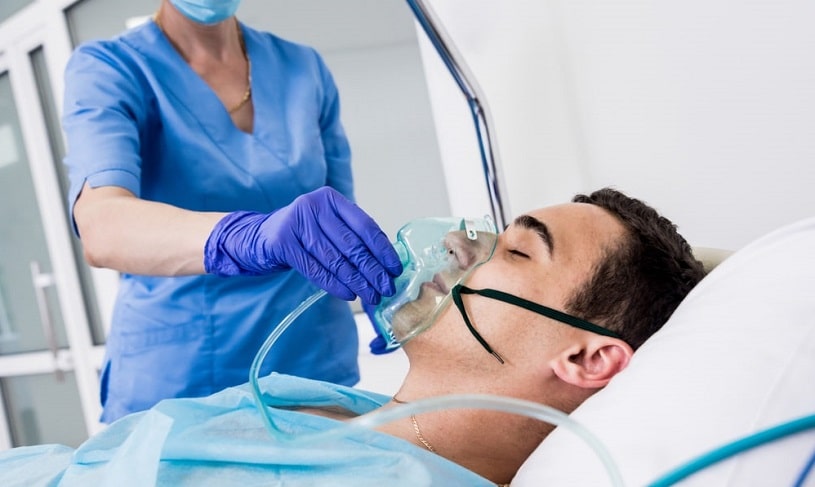There is a controversy regarding the pros and cons of rapid detox when it comes to helping people with addictions.
Some clinics and specialists claim that rapid drug detoxification is the easiest and fastest method to quit heroin, prescription painkillers, and other drugs. For some, the procedure might sound like a miracle, but few know the risks and complications, and very high costs that sedation detoxification comes with.
Table Of Contents:
What Is Rapid Detox
Rapid drug detoxification is officially called anesthesia-assisted opiate detox. It is a procedure commonly done in a medical setting. In this procedure, anesthesia is administered to the patient, and several substances are introduced into the patient’s body to remove opioids and other toxins. How long does a detox last? If done correctly, all traces of opioids would be out of a person’s body within 3 to 4 days.
Many of these recovering addicts think that this would save them from the pain of withdrawal. However, it’s not exactly as described. While this may indeed hasten the drug detox process, many do not know all its benefits and downsides. Additionally, this is not a cure for addiction.
That Said, It Is Essential to Know That There Are Two Main Types of Fast Detoxification, and They Are:
- Rapid detox. It is a type of detoxification that spans over three days to a week. Patients that undergo this process are put under anesthesia and administered substances that force the removal of harmful opioids.
- Ultra-rapid detox. In ultra rapid detoxification, the health practitioner sedates the recovery addict with anesthesia before the process begins. Opioid blockers are introduced to the patient’s body to start the process forcefully. By the time the patient wakes up, the withdrawal symptoms would have mostly disappeared.
Rapid Detox Process
Quick detoxification generally takes place over a few days. Many times, it significantly helps in cleansing the body of opioids.
Before the process starts, a responsible health practitioner asks the patient what detoxification process they prefer and makes recommendations. The process can occur while the patient is awake or asleep, depending on the type of rapid detox process chosen.

First, the anesthesia is introduced into the patient’s body. Shortly after, the medical practitioner administers opiate detoxification medications such as opioid blockers that hasten the removal of opioids and other harmful toxins. During the procedure, mild and severe withdrawal symptoms surface.
Some of the Effects of the Withdrawal Process While the Patient Is Asleep Include:
- Fever
- Runny nose
- Headaches
Other medications such as clonidine and clonazepam are administered to the patient to help cope with withdrawal symptoms. The process takes place for a few hours each day, and the patient tends to stay asleep during the process.
Is it Effective?
Many opiate detox centers use this procedure with some degree of success. For some people, rapid opiate detox under anesthesia does show results, helping them get rid of the addiction and the withdrawal effects in a short period. However, this depends on the period the person had the addiction if they suffer from other conditions and their overall health.
Many times, the claims made even by top-rated addiction treatment centers are pure advertising. Few of them inform their patients of the real danger of rapid drug detoxification. Clinical trials do not prove the method, and there is no evidence backed by science in the medical literature to prove that this technique is as effective and safe as other treatment approaches for drug addiction.
On the contrary, the American Society of Addiction Medicine did not approve rapid detox, claiming it is an unproven treatment, despite the few success stories, and that there are other safer alternatives. Addiction is a severe problem, and the treatment should address both the physical and mental aspects in a step-by-step approach.
That said, it is essential to point out that rapid opiate detox is not proven to be a better mode of treatment when compared to other detox plans. It certainly does not increase abstinence rates, and it is riskier in the long term.
A particular study conducted between 2000 to 2003 has made a massive effort to invalidate the above statement. In this statement, about 106 heroin-dependent patients were administered this form of care. The data from these studies show that general anesthesia did not have any significant effects on heroin detoxification.
Not only does it have little to no effect on the detoxification process, but several other reports show its effects. For example, a report from the CDC shows that in 2012, a 23-year-old man decided to undergo rapid detox. Due to his previous diagnosis of anxiety and depression, it had negative effects on him. He had several panic attacks and had to be administered benzodiazepines before he calmed down. He had suicidal thoughts and had to be admitted due to his mental instability.
From these facts, it is clear that the regular detoxification process is easier on the body when compared to fast detoxification. Although quick detoxification produces way more immediate results, it is a hazardous process to undergo. A study in 2003 validates this statement, seeing as the scientists of this study felt an increase in withdrawal symptoms of patients who went through fast detoxification.
Dangers Of Rapid Drug Detoxification
Even though it provides fast relief from withdrawal symptoms, fast detoxification comes with many dangers. Unfortunately, many of these dangers can lead to life-threatening situations.
That said, Below Are Some Of Them:
Withdrawal Symptoms
The first side effect this causes is withdrawal symptoms, which is quite ironic. Many people undergo this procedure thinking they’ve escaped the withdrawal. However, what about the emotional and mental health imbalances that remain?

Ultra rapid detoxification is good for flushing away harmful toxins from the body, but the brain remains unchanged due to the addiction. As a result, emotional and mood imbalances may occur, increasing the chance of relapse.
Relapse Risks
As mentioned earlier, rapid detox does not take away emotional imbalances or mental health disorders related to drug addiction. In fact, it can rapidly increase the chance of a relapse. Even after the process, a patient will still think and live like an addict. In addition, they will most likely not understand how to resist the temptation, causing them to relapse hard and abuse drugs.
Additionally, many clinics that perform the process of drug detox ignore other psychiatric problems the patients might have, like those caused by schizophrenia or depression, other drugs that they might abuse (illicit or prescription), or other emotional, behavioral, or social issues that have led to the addiction. That is why the risk of relapse and abuse is extremely high.
A medical journal showed a 91% relapse rate among patients who underwent rapid opiate detox, with 59% turning to drugs in the first week after the procedure.
Overdose
Rapid detoxification can significantly increase the chance of an overdose due to the body’s unpreparedness. When drugs are flushed from the body, it reduces the body’s ability to tolerate medications. If the patient relapses and starts retaking the same amount of drugs, it can lead to an overdose.
Mental Health Complications
Mental health disorders are common among drug addicts, and fast detoxification rapidly increases the severity of these disorders and the development of several other mental health conditions. Some of these mental health conditions include anxiety disorders, depression, and other mood disorders.
Side Effects of Rapid Detoxification
In addition to the dangers mentioned above, there are other side effects related to rapid drug detoxification.
They Include:
- Racing pulse
- Headaches
- Sweating
- Nausea
- Agitation
- Insomnia
- Seizures
- Trouble sleeping
- Muscle cramps
- Nausea
- Runny nose
- Goosebumps
- Diarrhea
Some of these side effects are mild, while some others can make the patient extremely uncomfortable. In addition, rapid opiate detox under anesthesia often leads to fatal situations when the patient overdoses.
Is It Too Good to Be True?
Though rapid opiate detox under anesthesia has been hailed as a reasonable new way to end an addiction, studies have suggested that the procedure itself carries various risk factors associated with overall physical and mental health.
The Most Common Concerns About the Quick Detox Process Include:
- Inefficacy
- No proof of safety
- Aggravation of mental health symptoms
- Serious health risks
- Fatality
There are no peer-reviewed studies regarding the safety of rapid drug detoxification. Even the Cochrane Database of Systematic Reviews has made public a warning regarding the risks of this method after analyzing six studies that showed an increased risk of side effects and even potential for life-threatening risks.
Rapid opiate detox comes with a series of risks and adverse effects, including life-threatening ones. Although the drugs are removed from the patient’s system, this process might harm the overall well-being and health.
The risks are much higher for people with any pre-existing medical conditions. Some experts have even drawn attention to the several deaths and many other near-death situations caused by fast and ultra rapid detoxification.
Rapid Detox Cost
Rapid opiate detox centers have different prices for this procedure, depending on what other services they include in the package. Depending on the detox centers and the services offered, the price is, on average, between 10,000$ to 15,000. Rapid detox cost can be even higher because the method implies intensive monitoring and sedation performed in the hospital.
Because this method is not considered medically safe and officially approved as addiction care, insurance companies usually do not cover the cost of this treatment.
Why Medical Detox Is Better
With all that being said, medical detox is better because it allows the patient to undergo the detox process naturally. Although detoxification may take a while, medical detox also significantly reduces the chance of relapse and fatal occurrences.

Many medical professionals follow up medical detox by assigning patients to rehabilitation centers that provide mental health therapies. It is essential because it allows the body and mind to adjust better towards the transition. Contact between the patient and centers is personalized and structured.
Seek Professional Help
Not having to deal with severe withdrawal symptoms after months or years of opiate intake sounds unbelievable and too good to be true.
If you’re struggling with drug addictions, it is not advisable to undergo rapid detox. While you may feel better after a day, the withdrawal symptoms come back, which may cause you to relapse.
Contact with professional help is critical to manage these addictions professionally and get you back on your feet properly.
Hope Without Commitment
Find the best treatment options. Call our free and confidential helpline
Most private insurances accepted
Page Sources
- Collins, E. D., Kleber, H. D., Whittington, R. A., & Heitler, N. E. (2005). Anesthesia-assisted vs buprenorphine-or clonidine-assisted heroin detoxification and naltrexone induction: a randomized trial. Jama, 294(8), 903-913. https://jamanetwork.com/journals/jama/fullarticle/201451
- Centers for Disease Control and Prevention. Deaths and Severe Adverse Events Associated with Anesthesia-Assisted Rapid Opioid Detoxification — New York City, 2012. https://www.cdc.gov/mmwr/preview/mmwrhtml/mm6238a1.htm
- Rapid and Ultra-Rapid Detoxification in Adults with Opioid Addiction: A Review of Clinical and Cost-Effectiveness, Safety, and Guidelines [Internet]. Ottawa (ON): Canadian Agency for Drugs and Technologies in Health; 2016 Jan 15. SUMMARY OF EVIDENCE. https://www.ncbi.nlm.nih.gov/books/NBK343903/
- Smyth, B. P., Barry, J., Keenan, E., & Ducray, K. J. I. M. J. (2010). Lapse and relapse following inpatient treatment of opiate dependence. Ir Med J, 103(6), 176-179. https://www.ncbi.nlm.nih.gov/pubmed/20669601
- Gowing, L., Ali, R., & White, J. M. (2010). Opioid antagonists under heavy sedation or anaesthesia for opioid withdrawal. Cochrane Database of Systematic Reviews, (1). https://pubmed.ncbi.nlm.nih.gov/16625552/
- Guerra, D., Solé, A., Camí, J., & Tobeña, A. (1987). Neuropsychological performance in opiate addicts after rapid detoxification. Drug and alcohol dependence, 20(3), 261-270. https://www.sciencedirect.com/science/article/pii/0376871687900366
- O’Connor, P. G., & Kosten, T. R. (1998). Rapid and ultrarapid opioid detoxification techniques. Jama, 279(3), 229-234. https://jamanetwork.com/journals/jama/article-abstract/187166













